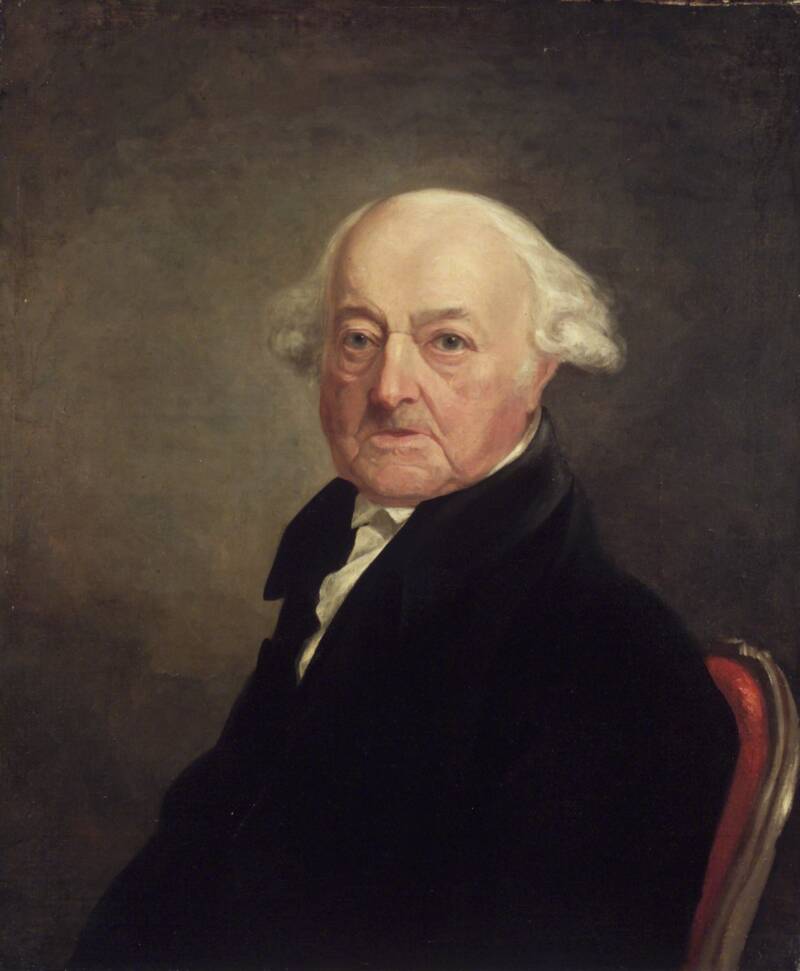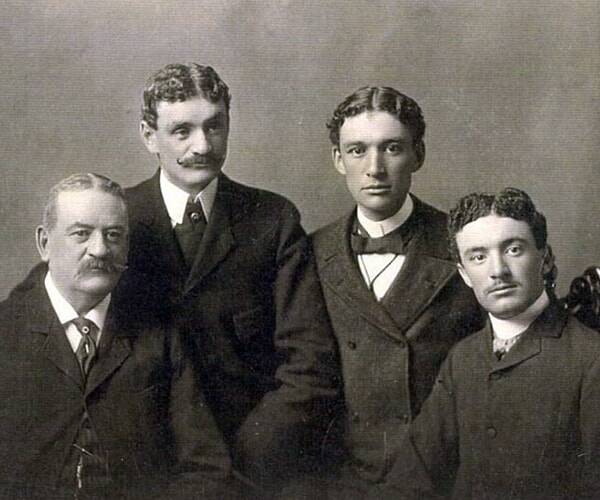Inside Thomas Jefferson’s Slow, Painful Death And The Bizarre Circumstances Surrounding It
In a strange twist of fate, Thomas Jefferson died on July 4, 1826 — the 50th anniversary of the adoption of the Declaration of Independence.
hen Thomas Jefferson died on a summer day in 1826, his death captivated Americans — not because of its cause, but because of the circumstances that surrounded it. The former president died on July 4, the 50th anniversary of American Independence. And Thomas Jefferson died just hours before John Adams, his fellow Founding Father.
It seemed a noble and fitting end for the man who wrote the Declaration of Independence. But in reality, Thomas Jefferson’s death was drawn-out and painful.
Almost a decade after he left the presidency, Thomas Jefferson began to suffer from a number of agonizing and debilitating health problems, including boils, swollen joints, periods of illness that left him prone for weeks, diarrhea, and painful urinary tract infections.
By the beginning of 1826, Jefferson’s health woes had worsened. The 83-year-old — famous for the power of his pen — even had difficulty writing. By June, he was bedridden. By July, he’d fallen into a confused stupor.
At that point, Jefferson asked the people gathered around his deathbed: Was it the fourth of July? Thomas Jefferson died on that famous date, July 4, at his Monticello plantation in Virginia. Five hours later, John Adams died in Massachusetts.
When Thomas Jefferson died, he was hailed as a great American. But his legacy has become more controversial in the centuries since.
Thomas Jefferson’s Swift Political Rise
Born in Virginia in 1743, Thomas Jefferson came of age as tensions between the American colonies and Great Britain intensified.

Public DomainThomas Jefferson in the 1780s.
As he attended college in the 1760s and began studying to be a lawyer, the British began to impose several new taxes on the American colonists. They sought to pay for debts accrued during the Seven Years’ War with a number of deeply unpopular acts, including the Stamp Act.
In 1774, a year after the Boston Tea Party, Jefferson penned A Summary View of the Rights of British America, which put forward his pro-independence views. In 1775, he attended the Second Continental Congress, and in 1776 Jefferson was selected to draft the Declaration of Independence.
In the aftermath, Thomas Jefferson served as the governor of Virginia, the U.S. minister to France, President George Washington’s secretary of state, and John Adams’ vice president. Then, in 1800, he was elected president himself.
He served two terms, during which he oversaw important developments like the Louisiana Purchase, then returned to his Monticello plantation in 1809. It was there, 17 years later, that Thomas Jefferson died. But Jefferson suffered from years of poor health before passing away at the age of 83 in 1826Inside The Former President’s Long Decline
According to the Monticello website, Thomas Jefferson’s health woes began in 1818. He’d gone to Warm Springs, Virginia, in hopes of alleviating his rheumatism in the mineral baths there, but contracted an infection on his buttocks.
 Matt Kozlowski/Wikimedia CommonsThomas Jefferson died at Monticello, his Virginia plantation where he spent his final years
Matt Kozlowski/Wikimedia CommonsThomas Jefferson died at Monticello, his Virginia plantation where he spent his final years“[There’s] a large swelling on my seat, increasing for several days past in size and hardness [that] disables me from sitting but on the corner of a chair,” Jefferson wrote to his daughter Martha on Aug. 21, 1818. “Another swelling begins to manifest itself to-day on the other seat.”
Though it appeared that Jefferson had a boil, he may have had sepsis. His doctors treated him with sulfur and mercury which helped the infection — but likely contributed to the former president’s chronic bowel problems.
The next year, Thomas Jefferson continued to suffer from various health inflictions including swollen limbs and bouts of weakness. In August 1819, he told a friend he’d had “the severest attack of rheumatism I have ever experienced. my limbs all swelled, their strength prostrate, & pain constant,” according to the Monticello website.
That same month, Jefferson told his daughter that he’d suffered “the most serious attack of that disease I ever had. while too weak to set up the whole day, and afraid to increase the weakness by lying down.”
Over the years, the former president also suffered from painful joints, a boil on his jaw, a fractured wrist, and bouts of illness that debilitated him for weeks. When Jefferson had trouble urinating in 1825, his doctor determined that he had an enlarged prostate. The doctor inserted bougies made of elastic gum through the urethra, which helped, but also introduced bacteria. This may have caused pyelitis — a painful pelvic infection.

Public DomainThe former president circa 1821. His health greatly declined in the 1820s, leading to Thomas Jefferson’s death in 1826.
“[As to] the state of my health… it is now 3. weeks since a re-ascerbation of my painful complaint [a severe attack of diarrhea and difficulty urinating] has confined me to the house and indeed to my couch,” Jefferson wrote in a letter in January 1826. “I write slowly and with difficulty.”
The former president’s health worsened over the next seven months, leading to Thomas Jefferson’s death in July. Oddly, he would die on both the 50th anniversary of American Independence and on the same day as his fellow Founding Father and ex-president, John Adams.
‘Thomas Jefferson Still Survives’: The Odd Circumstances Of Thomas Jefferson’s Death
Suffering from severe diarrhea, Thomas Jefferson was bedridden by June 1826. By July 2, he’d become groggy and easily confused.
On July 3, Jefferson slept for most of the day. He woke up that night, thinking it was still morning. According to three witnesses, his doctor Robley Dunglison, his grandson Thomas Jefferson Randolph, and the husband of one of his granddaughters, Nicholas Trist, Jefferson was concerned about the date. He wanted to know if it was July 4.

Public DomainThomas Jefferson died on July 4, 1826, the 50th anniversary of the adoption of the Declaration of Independence.
According to the Monticello website, Dunglison remembered Jefferson asking, “Is it the Fourth?” Randolph recalled that his grandfather asked twice, “This is the Fourth?” And Trist claimed that Jefferson stated: “This is the Fourth of July.”
Around four a.m. the next morning, Jefferson woke up long enough to ask to speak to his enslaved domestic workers — though it’s unknown what he said. Then, around noon, Thomas Jefferson died at the age of 83.
The Monticello website reports that Thomas Jefferson’s cause of death has never been definitively determined. He probably died from a number of different factors: his diarrhea, a kidney infection, kidney damage, and pneumonia. And if Jefferson had prostate cancer, he wouldn’t have lived much longer even with modern medicine.
But it’s not Thomas Jefferson’s cause of death that fascinated his fellow countrymen. It was a set of bizarre circumstances surrounding his death. First of all, Thomas Jefferson died on the 50th anniversary of the adoption of the Declaration of Independence — likely explaining his fixation on the date. And second, Jefferson died on the same day as John Adams.
The two men had had a complicated relationship. Though they’d started as friends, their opposing politics had driven a wedge between them. But Adams had reached out to Jefferson in 1812, initiating a correspondence that continued until both men’s deaths.

Public DomainAt the time of his death, John Adams believed that Jefferson was still alive. But Thomas Jefferson died five hours before Adams did on July 4, 1826.
And as John Adams lay dying in Massachusetts, Thomas Jefferson was on his mind. Unaware that his friend had died five hours earlier, Adams’ last words were allegedly: “Thomas Jefferson still survives!”
Slavery And Sally Hemings: The Complicated Legacy Of America’s Third President
In the aftermath of Thomas Jefferson’s death, he and John Adams were eulogized in newspapers and speeches across the country. Both were considered “great men,” and the nation mourned their demise.
However, Thomas Jefferson has a different reputation today.
As the author of the Declaration of Independence, he was long seen as an important pillar of American freedom. But Jefferson’s legacy is inextricably tied with slavery. He enslaved some 600 people during the course of his life. And Jefferson also had a sexual relationship with an enslaved woman, Sally Hemings.

MonticelloBeverly Frederick Jefferson, left, the grandson of Sally Hemings and Thomas Jefferson, with three of his sons. Circa 1900.
Jefferson and Hemings had at least six children together, but the truth of the matter was not definitively proven until a 1998 DNA test linked Hemings’ descendants to Jefferson. Their relationship likely started in the 1780s, when Hemings was just a teenager and Jefferson was in his 40s. And given Hemings’ status as an enslaved woman, she could not have given consent.
Two centuries after Thomas Jefferson’s death, his ownership of slaves and his relationship with Hemings casts a shadow on his legacy. Jefferson might have accepted the criticism levied against him today — he himself called slavery a “moral depravity” and a “hideous blot.” But he also enslaved people until the end of his life. And although Hemings’ children were freed, Sally Hemings remained enslaved until after Thomas Jefferson died. After reading about Thomas Jefferson’s death on the fourth of July, discover the story of James Callender, the 19th-century journalist who first exposed Jefferson’s relationship Sally Hemings. Or, look through these fascinating facts about every single U.S. president.
Comments
Post a Comment